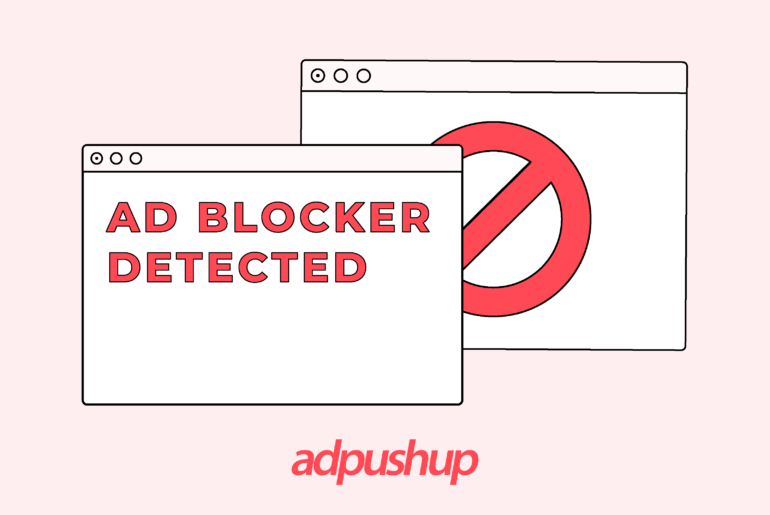Are ad blockers costing you money? Learn the top ways to Detect Ad Blockers and bypass them for a more profitable website.
As ad blocking grows globally, it becomes increasingly important for publishers who rely on ads for revenue to learn how to detect adblockers.
According to Statista, 34.2% of internet users in the United States use adblockers. Users install adblockers to remove ads from their web experience, and their numbers are growing every day. This can be a good thing for users, as it means they won’t have to see annoying ads. However, it’s bad for website owners, as it means they won’t make money from ads.
Also Read: All You Need to Know About Ad Blockers, Alternatives & More

Why Publishers Must Detect Adblockers?

Ad blockers are a nightmare for publishers. With over 42% of global internet users using ad blockers, publishers are beginning to worry about how this will affect their revenue in the future.
But ad blockers don’t affect all publishers equally. In order to calculate its effect, publishers need to know whether their visitors are using ad blockers or not.
Detecting ad blockers can provide insight into the revenue they are losing. Once that is known, publishers can work on measures to recover the lost revenue.
- So, how can a publisher detect an adblocker?
- Is ad blocker detection possible?
- What anti-ad blocker measures can publishers try?
Here are the answers.
By detecting ad blockers, website owners can ensure that their ads are only being shown to users who have not blocked them. This allows them to protect their revenue and maintain the financial sustainability of their website.
Additionally, having the ability to detect ad blockers allows website owners to identify which ads are being blocked and adjust their strategy accordingly.
It’s important for website owners to employ a method to detect adblocker that is both effective and user-friendly to avoid losing visitors due to a poor user experience.
How Can Publishers Detect Ad Blockers?
As a publisher, you might be making good money by running ads on your website. But you could make even more if ad blockers weren’t blocking ads.
This brings us to the topic— of how publishers can detect ad blockers. There are a few known applications, plugins, and JavaScript codes available, using which a publisher can detect whether ads are being displayed on their site or not.
Anti-ad blockers have a general idea about the webpage with ads: the expected webpage. Once this webpage is loaded on the user’s browser, an anti-ad blocker compares the rendered webpage with the expected webpage.
If the data doesn’t match, the website displays an anti-ad blocker message. Publishers like Forbes and BusinessInsider are already using anti-ad block methods.
4 Methods to Detect Ad Blockers
Ad Block Detection Scripts
Anti-ad blocker technology is a business now. There are a lot of providers offering applications, plugins, and scripts for publishers to put on their websites. Many ad-block detection scripts are available online which are easy to implement.
IAB Script
IAB (Interactive Advertising Bureau) is an advertising business organization. Their tech lab has designed an ad block detection script. According to IAB, the script is easy to implement.
You check the IAB GitHub page to access the detect ad-block script. The JavaScript (adblockDetector.js) has been tested on Chrome, Firefox, Internet Explorer and Safari Browser. You can find the installation and implementation details on the GitHub page of the IAB.
DetectAdBlock
DetectAdBlock simplifies the process of ad blocker detection. Here’s how it works:
Step 1: It starts with creating a hidden ‘div’ section to a file called “ads.js” and placing it in the root directory of your website.
var e=document.createElement('div');
e.id='mnMzPGBywKre';
e.style.display='none';
document.body.appendChild(e);Step 2: Now it’s time to place the ad block detection code in the HTML source code, just above the </body> tag. The purpose of this code is to detect if “ads.js” exists (ads are allowed) or not (ads are blocked).
<script src=”/ads.js” type=”text/javascript”></script>
<script type=”text/javascript”>
if(document.getElementById(‘mnMzPGBywKre’)){
alert(‘Blocking Ads: No’);
} else {
alert(‘Blocking Ads: Yes’);
}
</script>After detection, you can add a message asking to disable the ad blocker to access the content.
F**kAdBlock
F**kAdBlock also provides a free ad blocker detection script. Publishers can check out the GitHub page for the code and steps to implement it. The code presented by F**kAdBlock is more formalized. There are function declarations for ad block detection and no ad block detection. And then function definition, respectively.
The script works perfectly for AdBlock and AdBlock Plus. Also, it supports multiple web browsers (Chrome, Safari, Firefox, Internet Explorer, and Opera). Here is an example of how to detect ad blockers using the F**kAdBlocker code.
What To Do After Ad Blocker is Detected?
MarketingDive reports that around 30% of publishers are using some form of anti-ad blocker technology. This means that publishers are aware of this technology, and they are ready to take their chances with anti-ad blocking methods.
After a publisher detects that a user has an ad blocker enabled on their browser, there are several actions that they can take:
1. Show Non-Intrusive Ads
Publishers can consider showing non-intrusive ads, such as text-based ads or sponsored content, that are less likely to be blocked by ad blockers.
2. Request Users to Disable Ad Blocker
The publisher can display a message to the user asking them to disable their ad blocker in order to access the content on the website.
Publishers such as Forbes and Business Insider also display anti-ad blocker messages once they detect ad blockers. In order to access the content, the user needs to disable the ad blocker. And according to data, half of the users agree to disable their ad blocker to view the content.
3. Improve Ad Relevance
Showing relevant and interesting ads to the user may reduce the use of ad blockers as users may not feel the need to block them. In fact, according to Think with Google, viewers are 3X more likely to pay attention to ads that are relevant to them or feature people like them. Most of all, the audience will find the ads non-intrusive or annoying.
4. Improve Website Speed
Ad blockers may be used due to the slow loading time of ads, so publishers can improve website speed to reduce the use of ad blockers.
Ultimately, it’s important for publishers to strike a balance between protecting their revenue and providing a positive user experience. They should carefully consider the options and the potential impact on their audience before deciding on a course of action.
Also Check – Advanced Adblock Recovery Solution by AdPushup
How to Monetize in the Post-Adblock World
It can be beneficial for some publishers to look for an alternative rather than going for anti-ad block technology. Here are some methods to start with:
Adblock Recovery
Ad reinsertion technology has been in the market for quite some time now. Using this technology, the publisher can recover revenue lost to ad blockers without hurting the user experience. The idea is to serve acceptable ads to browsers actively using an ad blocker. However, ad reinsertion requires your ad tech partners to be whitelisted by the ad blocker creator.
Native Advertising
Native advertising is hard to detect with adblockers. This is due to the fact that native advertising blends with the webpage and its content. Have you noticed ‘sponsored’ posts on Facebook? These are native ads. Many magazines and news platforms are now also opting for native ads. One thing to keep in mind here is that native ads are hard to detect with ad blockers. But they are not impossible to detect and block.
Offer ‘Ad Free’ Subscriptions
This can be a good idea for publishers with rich content sites. Bloggers in the news and magazine niche have no product to sell, meaning that their content is their product. They make money by displaying ads. If visitors start using ad blockers, they notice a major drop in revenue. In such a case, creating an ‘ad free’ subscription for users can work well. This method is popular with mobile applications where the app publisher pitches the subscription by promising no ads.
Ask Nicely
Requesting users to disable their ad blockers can work. You can explain that display ads are important for your business. Explain your ad policy and reassure the user that you are not going to overwhelm them with loads of ads. In doing so, publishers can hope that their loyal users will disable the ad blocker and allow ads to be displayed on their web page.
Final Takeaways
The user has the right to use any kind of plugin and web extension on their device. And publishers and advertisers should respect that. If you look closely, ad blockers are not the culprit here. Annoying pop-ups, malvertising, redirect ads, and more; are the reasons why users choose to use an ad blocker.
Display ads are important for everyone (users, publishers, and advertisers). Blocking ads altogether can make the existence of free information on the web untenable. Publishers can detect ad blockers.
But what comes next? Lost revenue is not going to recover itself. Also, the user perception that ads are annoying and spammy is not going to change overnight. In the long term, publishers need to create their ad strategy keeping user experience in mind.
FAQs
If you don’t want your ad blocker extension to hinder your browsing experience, here are the best alternatives to ad blocking extensions.
a) Acceptable Ads
b) Adblock Recovery Solution
c) Using Native Ads
d) “Ad-Free” Subscriptions
One way to detect ad blockers is to check your browser extensions or add-ons. Another method is to use software such as:
a) AdwCleaner
b) Malwarebytes
c) Anti-Malware
d) SuperAntiSpyware
e) OptinMonster
This is how you can scan for adware or malware that may be blocking ads.
The answer is yes. When a user visits a website, adblocker prevents the website from loading ads. This means the loss of opportunity for publishers to get clicks or impressions that generate revenue.
There are two methods to track an adblocker using Google analytics.
1. Add JavaScript code to the website’s header. Set up a custom dimension in Google Analytics.
2. Add a DIV code to the web pages to detect ad blockers. Record the ad blockers in Google Analytics. Set up custom events in Google Analytics.

Deepak has a keen eye for detail and a deep understanding of the ad tech landscape. Whether it’s through in-depth articles, thought-provoking insights, or compelling storytelling, he’s dedicated to helping people navigate the complex world of ad tech with the simplicity of his words.







